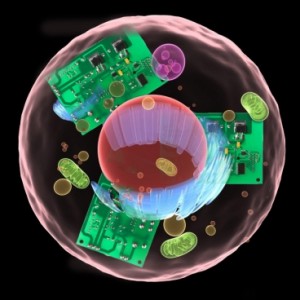Analog/digital, is there a difference? After reading the latest from MIT’s (Massachusetts Institute of Technology) Research Laboratory Electronics (RLE), the answer turns out to be no, when it comes to transistors. From the Sept. 29, 2011 news item on Nanowerk,
A transistor is basically a switch: When it’s on, it conducts electricity; when it’s off, it doesn’t. [emphases mine] In a computer chip, those two states represent 0s and 1s.
But in moving between its nonconductive and conductive states, a transistor passes through every state in between — slightly conductive, moderately conductive, fairly conductive — just as a car accelerating from zero to 60 passes through every speed in between. Because the transistors in a computer chip are intended to perform binary logic operations, they’re designed to make those transitional states undetectable. [emphases mine]
The MIT researchers will be discussing their work using analog transistors to increase the concentrations of two different proteins in cells. From the news item on Nanowerk,
At the Biomedical Circuits and Systems Conference in San Diego in November, Sarpeshkar [Rahul Sarpeshkar, associate professor of electrical engineering], research scientist Lorenzo Turicchia, postdoc Ramiz Daniel and graduate student Sung Sik Woo, all of RLE, will present a paper in which they use analog electronic circuits to model two different types of interactions between proteins and DNA in the cell. The circuits mimic the behaviors of the cell with remarkable accuracy, but perhaps more important, they do it with far fewer transistors than a digital model would require.
Here’s a graphic representation of transistors in a cell (downloaded from the MIT News Office page for this research,
This works seems to be signaling (pun noted) a change in how systems biology and synthetic biology researchers think about biological systems. From the Sept. 28, 2011 news item by Larry Hardesty for the MIT News Office,
Since the completion of the Human Genome Project, two thriving new disciplines — synthetic biology and systems biology — have emerged from the observation that in some ways, the sequences of chemical reactions that lead to protein production in cells are a lot like electronic circuits. In general, researchers in both fields tend to analyze reactions in terms of binary oppositions: If a chemical is present, one thing happens; if the chemical is absent, a different thing happens.
But Rahul Sarpeshkar, an associate professor of electrical engineering in MIT’s Research Laboratory of Electronics (RLE), thinks that’s the wrong approach. “The signals in cells are not ones or zeroes,” Sarpeshkar says. “That’s an overly simplified abstraction that is kind of a first, crude, useful approximation for what cells do. But everybody knows that’s really wrong.”
From what I understand of the synthetic biology and systems biology communities, this is a major change.
